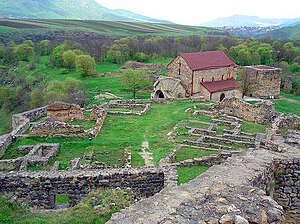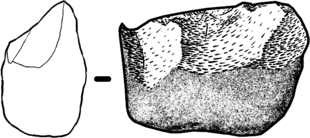Dmanisi

Dmanisi (Georgian: დმანისი) is a townlet and archaeological site in Kvemo Kartli region of Georgia approximately 93 km southwest of the nation’s capital Tbilisi in the river valley of Mashavera.
History
The town of Dmanisi is first mentioned in the 9th century as a possession of the Arab emirate of Tbilisi, though the area had been settled since the Early Bronze Age. An Orthodox Christian cathedral – “Dmansis Sioni” – was built here in the 6th century. Located on the confluence of trading routes and cultural influences, Dmanisi was of particular importance, growing into a major commercial center of medieval Georgia. The town was conquered by the Seljuk Turks in the 1080s, but was later liberated by the Georgian kings David the Builder and Demetrios I between 1123 and 1125. The Turco-Mongol armies under Timur laid waste to the town in the 14th century. Sacked again by the Turkomans in 1486, Dmanisi never recovered and declined to a scarcely inhabited village by the 18th century.
Archaeological site

Extensive archaeological studies began in the area in 1936 and continued in the 1960s. Beyond a rich collection of ancient and medieval artifacts and the ruins of various buildings and structures, unique remains of prehistoric animals and humans have been unearthed. Some of the animal bones were identified by the Georgian paleontologist A. Vekua with the teeth of the extinct rhino Dicerorhinus etruscus etruscus in 1983. This species dates back presumably to the early Pleistocene epoch.
The discovery of primitive stone tools in 1984 led to increasing interest to the archaeological site. In 1991, a team of Georgian scholars was joined by the German archaeologists from Römisch-Germanisches Zentralmuseum, and later the U.S., French and Spanish researchers.
The fascinating fossil hominin skulls and jaws described as Homo georgicus were found at Dmanisi between 1991 and 2005.
 |
 |
Subsequently, four fossil skeletons were found, showing a species primitive in its skull and upper body but with relatively advanced spines and lower limbs, providing greater mobility. The assemblage includes one of the largest Pleistocene Homo mandibles (D2600), one of the smallest Lower Pleistocene mandibles (D211), a nearly complete sub‐adult (D2735), and a completely edentulous specimen (D3900)[1]
According to David Lordkipanidze,[2][3] the leader of the project, the finds have been dated at 1.77 million years before the present, and he described the transitional position with regard to other early hominids in this way:
"The dental evidence from Dmanisi shows a unique combination of primitive and derived traits. In general, although the Dmanisi dental fossils show primitive morphology that resembles that seen in Australopithecus and H. habilis, they also display some derived characteristics, particularly in relation to dental reduction, resembling that seen in the dentition of H. erectus from the Far East."
See also
References
- ^ Rightmire, G. Philip; Van Arsdale, Adam P.; Lordkipanidze, D (2008). "Variation in the mandibles from Dmanisi, Georgia". Journal of Human Evolution. 54 (6): 904–8. doi:10.1016/j.jhevol.2008.02.003. ISSN 0047-2484. PMID 18394678.
{{cite journal}}: Unknown parameter|month=ignored (help) - ^ Wilford, John Noble (September 19, 2007). "New Fossils Offer Glimpse of Human Ancestors". The New York Times. Retrieved September 9, 2009.
- ^ Lordkipanidze, David; Vekua, Abesalom; Ferring, Reid; Rightmire, G. Philip; Zollikofer, Christoph P. E.; Ponce De León, Marcia S.; Agusti, Jordi; Kiladze, Gocha; Mouskhelishvili, Alexander (2006). "A fourth hominin skull from Dmanisi, Georgia". The Anatomical Record Part A: Discoveries in Molecular, Cellular, and Evolutionary Biology. 288 (11): 1146–57. doi:10.1002/ar.a.20379. ISSN 1552-4884. PMID 17031841.
{{cite journal}}: Unknown parameter|month=ignored (help)
External links
- Official Site
- Foley, Jim (January 13, 2009). "Skull D2700". TalkOrigins Archive. Retrieved September 9, 2009.
- Connor, Steve (September 9, 2009). "A skull that rewrites the history of man". The Independent. Retrieved September 9, 2009.
